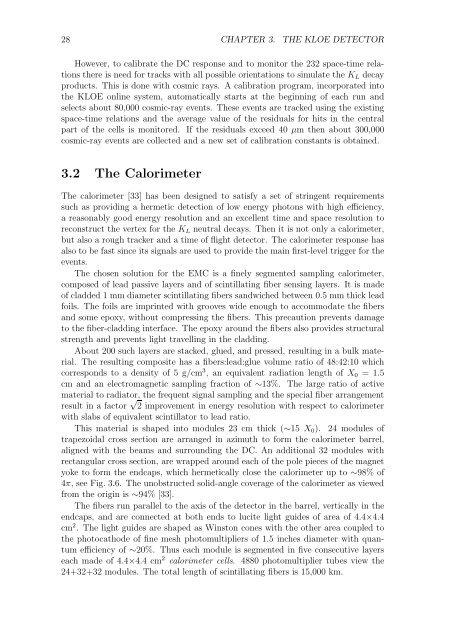Universit`a degli studi Roma Tre Measurement of the KL meson ...
Universit`a degli studi Roma Tre Measurement of the KL meson ...
Universit`a degli studi Roma Tre Measurement of the KL meson ...
You also want an ePaper? Increase the reach of your titles
YUMPU automatically turns print PDFs into web optimized ePapers that Google loves.
28 CHAPTER 3. THE <strong>KL</strong>OE DETECTOR<br />
However, to calibrate <strong>the</strong> DC response and to monitor <strong>the</strong> 232 space-time relations<br />
<strong>the</strong>re is need for tracks with all possible orientations to simulate <strong>the</strong> <strong>KL</strong> decay<br />
products. This is done with cosmic rays. A calibration program, incorporated into<br />
<strong>the</strong> <strong>KL</strong>OE online system, automatically starts at <strong>the</strong> beginning <strong>of</strong> each run and<br />
selects about 80,000 cosmic-ray events. These events are tracked using <strong>the</strong> existing<br />
space-time relations and <strong>the</strong> average value <strong>of</strong> <strong>the</strong> residuals for hits in <strong>the</strong> central<br />
part <strong>of</strong> <strong>the</strong> cells is monitored. If <strong>the</strong> residuals exceed 40 µm <strong>the</strong>n about 300,000<br />
cosmic-ray events are collected and a new set <strong>of</strong> calibration constants is obtained.<br />
3.2 The Calorimeter<br />
The calorimeter [33] has been designed to satisfy a set <strong>of</strong> stringent requirements<br />
such as providing a hermetic detection <strong>of</strong> low energy photons with high efficiency,<br />
a reasonably good energy resolution and an excellent time and space resolution to<br />
reconstruct <strong>the</strong> vertex for <strong>the</strong> <strong>KL</strong> neutral decays. Then it is not only a calorimeter,<br />
but also a rough tracker and a time <strong>of</strong> flight detector. The calorimeter response has<br />
also to be fast since its signals are used to provide <strong>the</strong> main first-level trigger for <strong>the</strong><br />
events.<br />
The chosen solution for <strong>the</strong> EMC is a finely segmented sampling calorimeter,<br />
composed <strong>of</strong> lead passive layers and <strong>of</strong> scintillating fiber sensing layers. It is made<br />
<strong>of</strong> cladded 1 mm diameter scintillating fibers sandwiched between 0.5 mm thick lead<br />
foils. The foils are imprinted with grooves wide enough to accommodate <strong>the</strong> fibers<br />
and some epoxy, without compressing <strong>the</strong> fibers. This precaution prevents damage<br />
to <strong>the</strong> fiber-cladding interface. The epoxy around <strong>the</strong> fibers also provides structural<br />
strength and prevents light travelling in <strong>the</strong> cladding.<br />
About 200 such layers are stacked, glued, and pressed, resulting in a bulk material.<br />
The resulting composite has a fibers:lead:glue volume ratio <strong>of</strong> 48:42:10 which<br />
corresponds to a density <strong>of</strong> 5 g/cm 3 , an equivalent radiation length <strong>of</strong> X0 = 1.5<br />
cm and an electromagnetic sampling fraction <strong>of</strong> ∼13%. The large ratio <strong>of</strong> active<br />
material to radiator, <strong>the</strong> frequent signal sampling and <strong>the</strong> special fiber arrangement<br />
result in a factor √ 2 improvement in energy resolution with respect to calorimeter<br />
with slabs <strong>of</strong> equivalent scintillator to lead ratio.<br />
This material is shaped into modules 23 cm thick (∼15 X0). 24 modules <strong>of</strong><br />
trapezoidal cross section are arranged in azimuth to form <strong>the</strong> calorimeter barrel,<br />
aligned with <strong>the</strong> beams and surrounding <strong>the</strong> DC. An additional 32 modules with<br />
rectangular cross section, are wrapped around each <strong>of</strong> <strong>the</strong> pole pieces <strong>of</strong> <strong>the</strong> magnet<br />
yoke to form <strong>the</strong> endcaps, which hermetically close <strong>the</strong> calorimeter up to ∼98% <strong>of</strong><br />
4π, see Fig. 3.6. The unobstructed solid-angle coverage <strong>of</strong> <strong>the</strong> calorimeter as viewed<br />
from <strong>the</strong> origin is ∼94% [33].<br />
The fibers run parallel to <strong>the</strong> axis <strong>of</strong> <strong>the</strong> detector in <strong>the</strong> barrel, vertically in <strong>the</strong><br />
endcaps, and are connected at both ends to lucite light guides <strong>of</strong> area <strong>of</strong> 4.4×4.4<br />
cm 2 . The light guides are shaped as Winston cones with <strong>the</strong> o<strong>the</strong>r area coupled to<br />
<strong>the</strong> photocathode <strong>of</strong> fine mesh photomultipliers <strong>of</strong> 1.5 inches diameter with quantum<br />
efficiency <strong>of</strong> ∼20%. Thus each module is segmented in five consecutive layers<br />
each made <strong>of</strong> 4.4×4.4 cm 2 calorimeter cells. 4880 photomultiplier tubes view <strong>the</strong><br />
24+32+32 modules. The total length <strong>of</strong> scintillating fibers is 15,000 km.
















